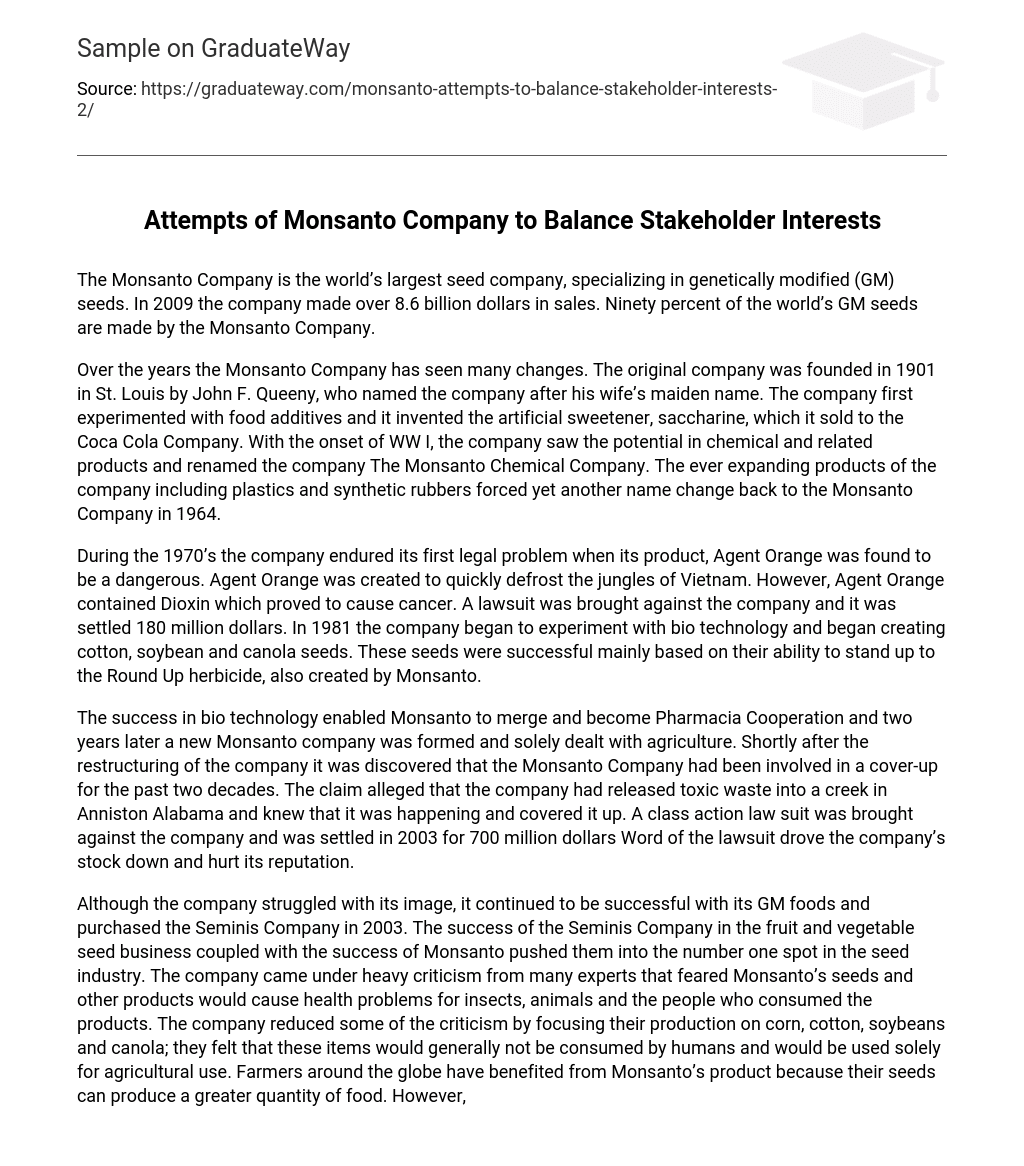The Monsanto Company is the world’s largest seed company, specializing in genetically modified (GM) seeds. In 2009 the company made over 8.6 billion dollars in sales. Ninety percent of the world’s GM seeds are made by the Monsanto Company.
Over the years the Monsanto Company has seen many changes. The original company was founded in 1901 in St. Louis by John F. Queeny, who named the company after his wife’s maiden name. The company first experimented with food additives and it invented the artificial sweetener, saccharine, which it sold to the Coca Cola Company. With the onset of WW I, the company saw the potential in chemical and related products and renamed the company The Monsanto Chemical Company. The ever expanding products of the company including plastics and synthetic rubbers forced yet another name change back to the Monsanto Company in 1964.
During the 1970’s the company endured its first legal problem when its product, Agent Orange was found to be a dangerous. Agent Orange was created to quickly defrost the jungles of Vietnam. However, Agent Orange contained Dioxin which proved to cause cancer. A lawsuit was brought against the company and it was settled 180 million dollars. In 1981 the company began to experiment with bio technology and began creating cotton, soybean and canola seeds. These seeds were successful mainly based on their ability to stand up to the Round Up herbicide, also created by Monsanto.
The success in bio technology enabled Monsanto to merge and become Pharmacia Cooperation and two years later a new Monsanto company was formed and solely dealt with agriculture. Shortly after the restructuring of the company it was discovered that the Monsanto Company had been involved in a cover-up for the past two decades. The claim alleged that the company had released toxic waste into a creek in Anniston Alabama and knew that it was happening and covered it up. A class action law suit was brought against the company and was settled in 2003 for 700 million dollars Word of the lawsuit drove the company’s stock down and hurt its reputation.
Although the company struggled with its image, it continued to be successful with its GM foods and purchased the Seminis Company in 2003. The success of the Seminis Company in the fruit and vegetable seed business coupled with the success of Monsanto pushed them into the number one spot in the seed industry. The company came under heavy criticism from many experts that feared Monsanto’s seeds and other products would cause health problems for insects, animals and the people who consumed the products. The company reduced some of the criticism by focusing their production on corn, cotton, soybeans and canola; they felt that these items would generally not be consumed by humans and would be used solely for agricultural use. Farmers around the globe have benefited from Monsanto’s product because their seeds can produce a greater quantity of food. However, some areas like Europe have still refused to use their products due to the health concerns and the environmental effects they may have.
In 2002 the company again dealt with legal issues when it was alleged that a Senior Manager instructed an Indonesian consulting firm to pay a bribe of $50,000 to disguise an invoice that showed farmers in Indonesia were concerned about their products. An investigation showed that bribery was an ongoing issue for the company dating back to 1997. Monsanto accepted responsibility for the briberies and agreed to pay 1 million dollars to the Department of Justice and a 500 thousand dollar fine to the SEC.
Case Questions
1. Does Monsanto maintain an ethical culture that can effectively respond to various stakeholders?
The company has tried to maintain an ethical culture with various stakeholders but the continuous legal problems make it difficult. They used the concept of Social Responsibility and Business Ethics to create a reputation value to various stakeholders. They have made donations to various entities to conduct research on agriculture and ways to maintain health and hygiene. They have also encouraged students to become interested in agriculture. However, many farmers have become frustrated with the regulations placed on their use of Monsanto’s products.
2. Compare the benefits of growing GMO seeds for crops with the potential negative consequences.
Since these have been introduced to the United States and around the globe many farmers have seen an improvement in the production of crops. This has lowered expenses and raised profits significantly. The farmers who utilize Monsanto’s products have been able to use half the amount of land they used to but double the size of their crops. The concern of those who question the safety of these products is that farmers will continue to use them and ignore the health hazards as long as they are making a profit. However, the FDA clarified that “biotech crops are safe to use”, but critics have doubts because the long term effect of these products is still unknown.
3. How should Monsanto manage the potential harm to plant and animal life from using products such as Roundup?
Monsanto should utilize all of their resources, including their substantial profits, and create a set of policies and procedures to ensure that their products are as safe as possible. They should also invite others, including government officials to conduct their own tests and make suggestions on how the products that Monsanto release to the public are free of health hazards. Open forums should be conducted with the public to share ever changing information on the world of GM foods. If at any time there is a concern over a particular product, it should be pulled of the market until it has been deemed safe by Monsanto and any overseeing agency.
References
Ferrell, Fraedrich & Ferrell (2011) Business Ethics: Ethical Decision Making and Cases pp 302-313





